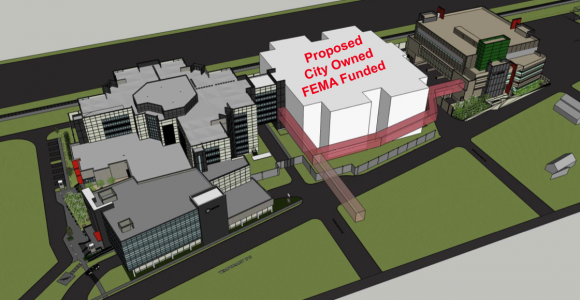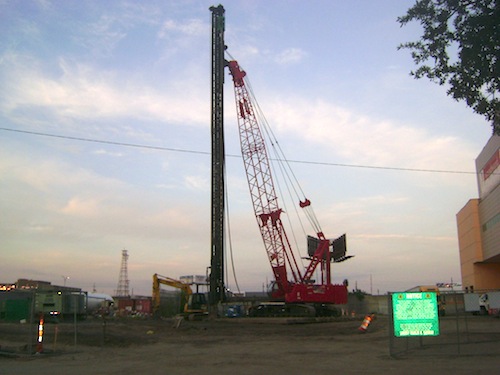
Sheriff Marlin Gusman and city officials are in quiet discussions to build another new jail facility within the Orleans Parish Prison complex, creating room for more than 600 inmates, according to recent correspondence and drawings obtained by The Lens.
This comes despite a City Council vote last year that limits capacity at the complex to 1,438, as well as recent public pledges by key officials – Gusman included – to limit capacity to that total.
It’s unclear when talks started in earnest about moving forward with the new building, but they were underway by the time Gusman wrote to city Chief Administrative Officer Andy Kopplin on May 25.
“As we discussed, enclosed is a bed count and distribution on Phase III,” Gusman wrote.
The new facility would hold inmates with medical needs and mental-health issues; New Orleans residents returning from state prisons who are working in re-entry programs; and minimum-security male inmates, according to the emails.
“That would give us a total of 654 beds in the next phase,” Gusman wrote. “These would be mostly dormitories with the exception of special housing for Medical and Mental Health. To get it to 600, we may want to focus on more medical and mental health reductions.”
The letters were produced by the city under a public records request filed by The Lens for jail-related correspondence between Kopplin and Gusman.
In the sweeping FEMA-financed post-Katrina rebuilding at the Orleans Parish Prison complex, Phase I is the new kitchen and warehouse facility that is nearly complete and adjacent to Interstate 10. Phase II is the 1,438-bed facility, now in the early stages of construction a block away.
An empty city-owned block between the two would be the site of the new 654-inmate facility.
The new building is a departure from Gusman’s earlier stance that it might be a good idea to have “a little green space” between Phase I and Phase II.

This week, a pile-driver was on the empty site to prepare for a new sewerage system and other infrastructure to connect the two buildings under construction, said Marc Ehrhardt of the Ehrhardt Group, a public relations company that works for Gusman.
Under the conditions set by the 2011 ordinance approving the Phase II construction, Gusman is limited to space for 1,438 inmates – unless the mayor or the City Council takes other action. No such action has been taken or publicly discussed.
Nearly all other facilities in the complex are to be closed when Phase II opens; a just-opened 400-bed temporary facility would have to be closed within 18 months.
Mayor Mitch Landrieu’s Criminal Justice Working Group – which is run by Kopplin– continued meeting after the city passed the ordinance commissioning the new, 1,438-bed jail.
The mayor formed the advisory group to determine the maximum number of inmates the Orleans Parish Prison should have, with a deadline of November 2010. It still hasn’t come up with that figure.
Members have said the number of jail beds needed for New Orleans would be between 1,750 and 3,100.
The lower number, officials said, was based on an effective pretrial release program implemented by the Vera Institute for Justice. The program was launched earlier this year.
The inmate population in the entire Orleans Parish Prison complex this week stood at about 2,600, Gusman said at a recent news conference. He has previously said that he has 2,691 beds available on any given day.
Even after the city wrote its law provisionally capping the new jail at 1,438 beds, it was simultaneously working to expand that number.
“The Jail Working Group agreed then that there was still work to be done as it relates to future use of city-owned property,” said mayoral spokesman Ryan Berni. The city, he said, is “evaluating how many additional jail beds will be needed for local prisoners, state DOC prisoners, re-entry programs and mental health and substance abuse beds.
“A final number of beds based on that programming has not been determined,” said Berni.
Presented with a copy of the letter he sent to Kopplin, Gusman was asked if this meant the city and sheriff’s office were in agreement on the inevitability of another jail facility.
“We’re still talking,” he said.
Gusman made the point that special-needs populations require special facilities.
“We don’t want to fit those populations in facilities that are less than desirable,” said Gusman. “This has always been about us having the most up-to-date, best practices facilities.”
City officials are loath to give any indication of what will become of the city-owned tract between the buildings under construction.
But the city’s website offered a diagram of a proposed new building that would be owned by the city and funded by FEMA. After unearthing the diagram from the city’s website about a month ago, The Lens was unable to locate it again this week. “The graphic was not a part of any city document that I am aware of,” said Berni.
The Lens also obtained design schematics from Kopplin of the proposed three-story building, showing that the “Phase III Concept Plan” includes beds for special needs populations, and open dormitory space for reentry and minimum-security inmates.
The new building is not going to be a stand-alone structure plopped between the other facilities. According to the diagram and drawings, it will be connected by enclosed bridges to the other buildings under construction.
Several jail buildings – generally owned by the city but operated by Gusman – have already been decommissioned or demolished since the city green-lighted the new jail last year, and the city is trying to clear equipment out of yet another.
The House of Detention was shut down by Gusman earlier this year, though he is still using its laundry and kitchen facilities, along with using space for visits and attorney-inmate consults. The South White Street facility, which housed female inmates, has been demolished.
According to records obtained by The Lens, Mayor Mitch Landrieu asked Gusman earlier this year to move telephone and computer equipment from the city-owned and otherwise abandoned Community Correctional Center to the new kitchen and warehouse building.
Gusman shot down that plan in an email to city officials, and attached a response from Ken Ball of the Orleans Parish Criminal Sheriff’s Office Recovery Program.
“At present, there is no open space large enough to accommodate the IT equipment,” Ball wrote. “The total cost impact would be greater than building a stand-alone building.”
The 1,438 figure is one of the biggest political issues in town, with reform advocates in the criminal-justice community demanding that the new jail not eclipse that number under any circumstance.
The faith-based Micah Project called a meeting on April 24 that was attended by more than 400 church members from various denominations around New Orleans. Organizers demanded that city officials pledge to stick to the 1,438 figure.
City Crime Commissioner James Carter, along with Kopplin, Gusman and a representative from Councilwoman Susan Guidry’s office, all agreed, though Kopplin later backed away from that figure as a total. Guidry is also a member of the Mayor’s Criminal Justice Working Group.
Gusman, in grudgingly accepting the 1,438 figure, has repeatedly warned against getting too wedded to that figure, which, he said, could severely hurt the safety of New Orleans residents.
“We have to be realistic about the city we live in today,” he said recently. “We are engaged in a relentless struggle with violent crime.”
The Micah Project participants were asked to pledge to fully decommission old Orleans Parish Prison buildings once the new jail is completed next year.
Gusman offered an unqualified “yes.”
Kopplin hedged. “Yes, but we may want to keep some re-entry beds” for state prisoners from elsewhere returning to New Orleans, he said.
The May 25 letter from Gusman to Kopplin said the Phase III plan for a new jail building would include 256 beds for re-entry.



